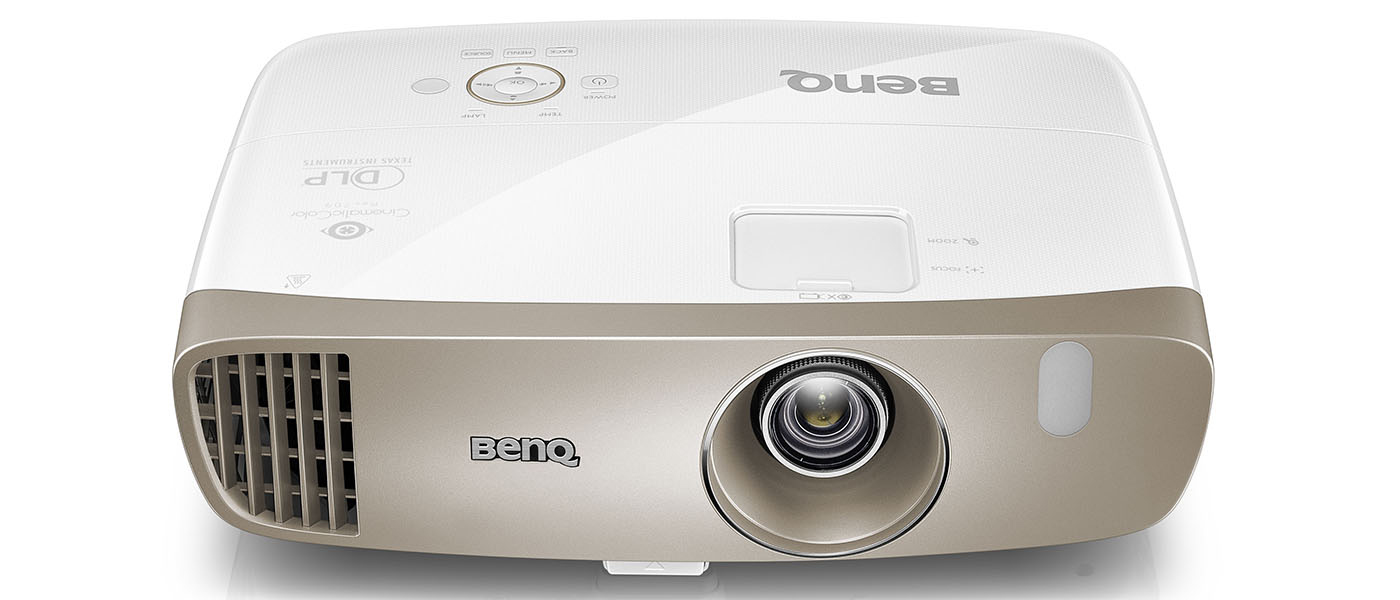I’ve reviewed models from Epson and JVC; now BenQ is in the mix with its new HT9050 from the CinematicColor line. It marks a departure from their usual compact models with a 20,000-hour LED light engine and an advanced DMD from Texas Instruments that incorporates XPR technology to deliver 3840×2160-pixel resolution through a premium lens. Generous shift and zoom are provided for flexible installation in a wide variety of environments. A single-chip design eliminates the convergence errors of its LCD and LCoS-based competition. DLP’s clarity with 8.3 mega-pixels, what could be better?
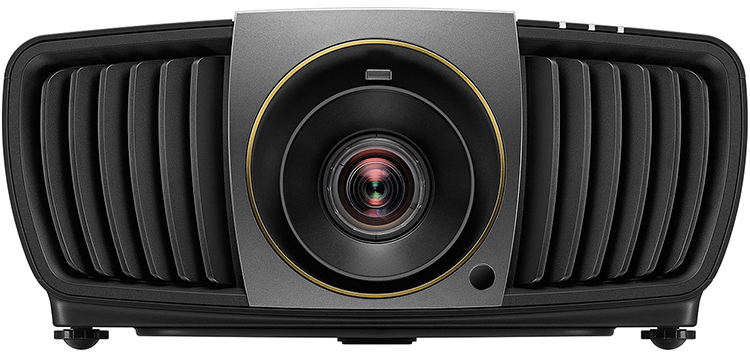
BenQ HT9050 Ultra HD DLP Projector
- Single-chip DLP with 2716×1528 native resolution
- XPR pixel-shift technology provides full 3840×2160 resolution
- Philips HLD ColorSpark LED light engine with 20,000-hour service life
- 2200 lumens output
- Generous lens shift with wide zoom range
- DCI-P3 and Rec.709 color options
- Anamorphic lens support
I have long been a fan of BenQ’s DLP models. They offer tremendous performance at every price point while delivering excellent value. After seeing Ultra HD offerings using LCD and LCoS engines, I was anxious to experience what the HT9050 Ultra HD DLP Projector with CinematicColor Technology could deliver. DLP is the only micro-display type that can create an image from a single chip. This eliminates the convergence errors inherent to three-chip LCD and LCoS designs. It also offers fast response with no motion blur because unlike its two competitors, it is not a sample-and-hold technology. It can render frames with zero lag between refresh cycles. With XPR technology delivering a full 3840×2160 pixels through a premium lens, this LED-lit projector offers an excellent alternative to other mainstream models. Let’s take a look.
Light engine:
Single-chip DLP with XPR technology
Native resolution:
2716×1528, 3840×2160 with pixel shift
3D:
No
Throw ratio:
1.36-2.03
Lens shift:
+65% vertical, +27% horizontal
Maximum image size:
300”
Anamorphic lens support:
Yes
Auto-iris:
No
Light source:
Philips HLD ColorSpark LED
Light output (mfr):
2200 lumens
Fan noise:
31/23dB (Normal, Economic)
Video connections:
1 x HDMI 2.0 w/HDCP 2.2, 1 x HDMI 1.4, 1 x VGA
Additional connections:
RS-232, Ethernet, IR input, 2 x 12v trigger out
LED service life:
20,000 hours
Dimensions:
8.9” H x 18.5” W x 22.2” D
Weight:
40.8lbs
Warranty:
Three years
BenQ HT9050 Ultra HD DLP Projector Price:
$8999
Company:
SECRETS Tags:
BenQ, HT9050, Ultra HD Projector, DLP Projector, Philips HLD ColorSpark, XPR, Projector Reviews 2017
- BenQ HT2150ST DLP Projector
- JVC DLA-RS4500 4K Projector
- Epson Pro Cinema 6040UB LCD Projector
- Epson Pro Cinema LS10000 Laser Projector
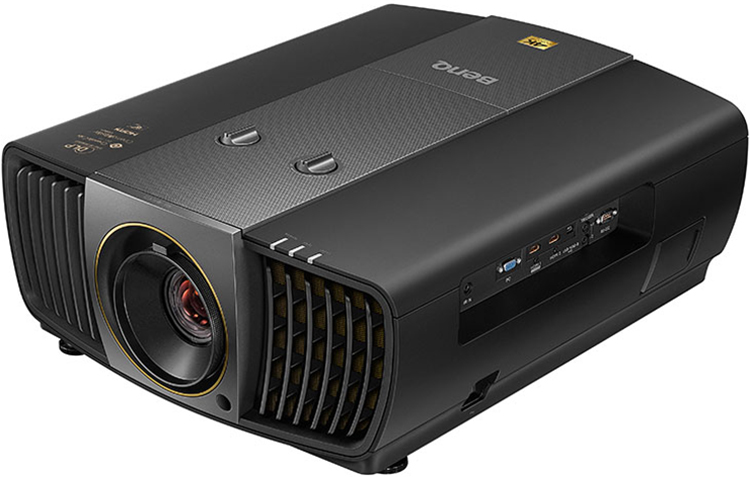
You’ve already seen from the specs that the HT9050 Ultra HD DLP Projector is not a true native 4K machine. Its DMD has a native resolution of 2716×1528 pixels along with a refractor module that optically shifts each pixel by one-half width every other refresh cycle. This fools the eye into perceiving 3840×2160 resolution. Similar technologies exist in Epson and JVC models. Is it as effective in rendering Ultra HD content as a native display? That is a matter of opinion. I recently reviewed the JVC RS4500 which has a native resolution of 4096×2160 and a high-end lens. It looked fantastic; which it had better considering its $35,000 cost.
The merits of pixel-shift have been debated and discussed at length by many, and I have experienced JVC and Epson’s versions first-hand. Upon installing the HT9050 and viewing both test patterns and actual content, I believe the XPR technology used here is the best yet and when showing quality material, can easily match the clarity of a true 3840×2160 display.
Secrets Sponsor
The Ultra HD standard includes not only resolution specs but values for an extended color gamut and HDR. The HT9050 scores well on the former but unfortunately omits the latter. There is no support at present for either HDR10 or Dolby Vision. How this will affect the viewing experience is something I’ll discuss later.
The HT9050 succeeds the HT8050 by replacing its UHP lamp with a Philips HLD ColorSpark LED light engine. Its spectral properties allow for a native gamut that fully meets the DCI-P3 specification, which is how the current crop of Ultra HD Blu-rays are mastered. It also means no more bulb changes as it is rated for a service life of 20,000 hours.
The lens is a 14-element, 6-group array with a 1.5x zoom and generous shift. You get 65% vertical in both directions and 27% horizontal. That should enable one to install the projector just about anywhere. The controls are manual and consist of small dials atop the chassis. Zoom and focus are accomplished with lens barrel adjusters. While I missed the motorized functions, BenQ’s mechanicals are very precise. Dialing in image geometry was a simple affair.
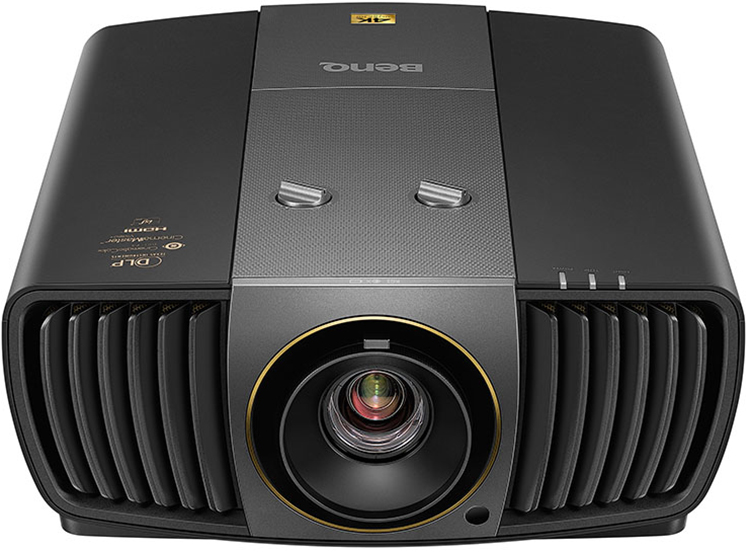
The chassis is large and heavy at just over 40 pounds. Build quality is tank-like with a high-quality finish that reflects no light. The only visible controls are the aforementioned lens shift knobs. A small sliding door on one side conceals a few buttons for menu navigation and source selection. Ventilation is handled by louvers flanking the lens and a large grill in back. The fan is one of the quietest I’ve ever experienced. In the Economic mode, it wouldn’t even register on my SPL meter. Even in the Normal light mode, it barely makes a sound.
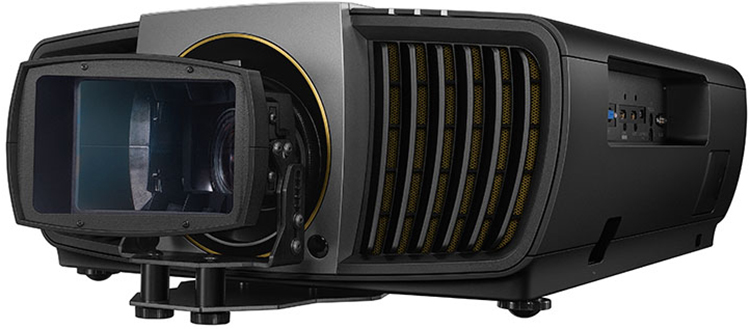
The HT9050 supports anamorphic lenses with an aspect ratio mode in the OSD and mounting lugs on the bottom of the chassis. You can install both constant-height and constant-width hardware depending on your screen’s shape and size.
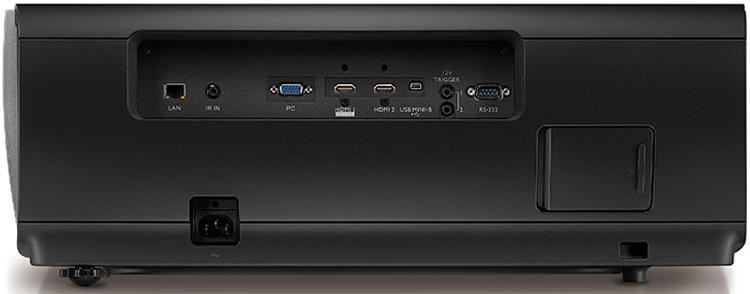
The input panel is on the left side and contains one HDMI 2.0 port with HDCP 2.2, one HDMI 1.4, one VGA, and control via RS-232, LAN, and two 12v triggers. IR receivers are in evidence on both the front and back.
The remote is very different from the tiny handsets I usually get with BenQ projectors. It’s a proper wand with a soft orange backlight that’s just perfect in completely dark rooms. It features discrete power keys along with menu navigation, source selection, and one-button access to calibration options like color temp and color management. There are also keys for 3D and a dynamic iris, both of which are absent on the HT9050. It makes me wonder if these features will be added at some point.
The HT9050 was installed on a stand behind my seating with the lens slightly above the screen’s center axis. This approach utilizes minimal lens shift and allows for maximum light output. The pattern generator and other video components were connected to the HDMI 1 input which supports HDCP 2.2 and accepts signals up to 3840×2160 pixels at 60Hz. I used an OPPO BDP-93 for standard Blu-ray and a Philips BDP-7501 to view Ultra HD content.
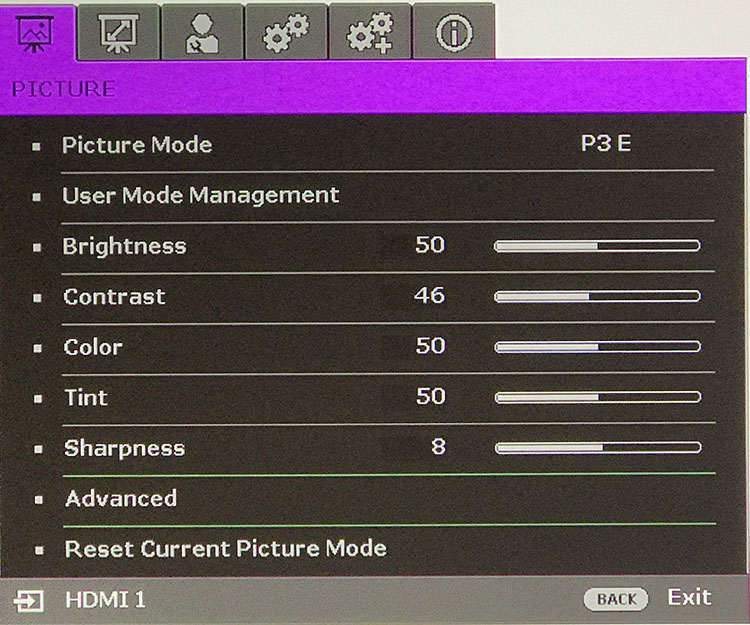
The menu system is laid out like any other BenQ projector and includes a set of very precise calibration controls along with five picture modes. Cinema corresponds to Rec.709 and is appropriate for standard hi-def content. DCI-P3 delivers just what it claims and is the one to pick for Ultra HD Blu-ray. Also included are Bright and Vivid which deliver greater output, up to 88fL in Bright mode. I also found a Silence preset which quiets the fan to an inaudible level and turns off the XPR pixel-shift feature. Two user memories allow you to create customized presets from any of the other modes. I set up calibrated configurations for DCI-P3 and Rec.709. If you have the appropriate passcode, ISF Day and Night modes can be enabled and calibrated as well.
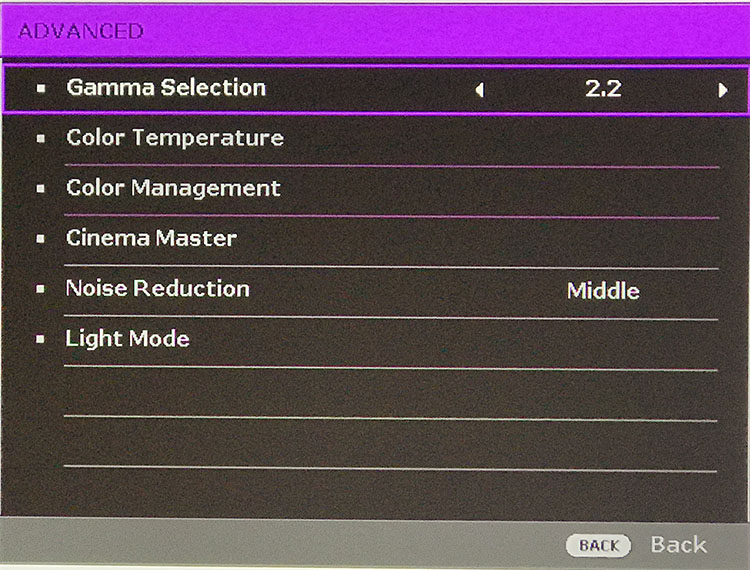
In the Advanced sub-menu, there are 11 gamma presets ranging from 1.6 to 2.8. 2.2 is the best choice in both Rec.709 and P3 colorspaces. The Color Temperature menu has four presets, all of which are adjustable with a two-point control. The gradations are super-small which affords high precision but also requires patience. You may have to adjust a particular slider by dozens of clicks to see a change. The color management system has hue, gain, and saturation controls for all six colors. Again, I had to make some large changes to dial in accurate color. The HT9050 is a bit off-spec in its default modes. I strongly recommend calibration, regardless of application.

CinemaMaster is something I haven’t seen in other BenQ projectors. It has sliders for color enhancement, flesh tones, and 4K Pixel Enhancer which is a form of edge enhancement. I left these alone. You also get toggles for color and luminance transient improvement, abbreviated DCTI and DLTI. Neither was able to improve the already sharp image I was seeing. In addition to a three-step noise reduction option, you get two light levels, Economic, good for around 38fL; and Normal which provides just over 56fL in the calibrated modes.
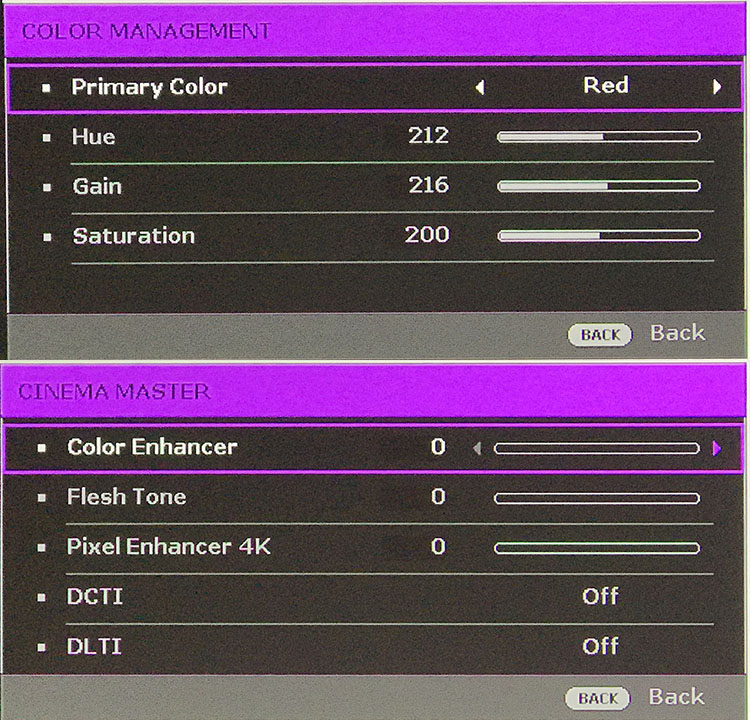
Calibrating the two color gamuts required a fair amount of work, especially in the CMS; but in the end, I achieved superb results that were well worth my time. The HT9050 is capable of reference-level accuracy and at this price point, one should realize the highest possible performance from their display.
Secrets Sponsor
If you’re looking for an auto-iris, there is none. This to me is the most unfortunate omission because no DLP can match black levels with an LCD or LCoS display without one. The lack of HDR support is something I can live with since no projector really has the native contrast necessary to make the most of it. But an iris, even a manual one, would be a real asset to the HT9050.
If you’re considering moving up to an Ultra HD projector, the top question in your mind is likely to be, will my 1080p content look better? After all, Ultra HD Blu-ray is an emerging format. It’ll be a few years before most of us update our movies to the higher-res versions. The answer is a resounding – yes! The HT9050 does a superb job upconverting standard Blu-rays.

I turned to the latest content which already looks amazing on my reference Anthem projector to see just how much difference a quality Ultra HD display can make. Kong: Skull Island is one of the best transfers I’ve seen of late and its clarity was taken to eye-popping levels on the HT9050. From my 10-foot seating distance, I had no trouble distinguishing the pores on actors’ skin, or the individual hairs of Kong’s fur. Textured surfaces like rough metal or wood literally leapt from the screen.
Now a word about contrast. With no iris included, the HT9050 does not excel in the dynamic range department. That being said, there were only a few instances where I actually noticed. In scenes with a wide range of luminance values, black levels seemed deep thanks to extremely bright highlights that were beautifully delineated from the background. Comparing medium and bright-toned material to my Anthem, the BenQ simply crushed it. 38fL peak sounds too bright but trust me, in practice, it creates an amazing sense of depth. Only the darkest scenes, those without any highlights, looked a bit washed out.
Moving on to Passengers, I really enjoyed the HT9050’s portrayal of the ship’s squeaky-clean interior, much of which I suspect is CGI. Close-ups of the characters’ faces were once again so real I could almost smell them. Laurence Fishburne rocks one of the roughest five-o’clock shadows I’ve ever seen. I felt as though it might abrade me if I got too close! Color was also top-notch, even though I was watching in the Rec.709 gamut. Primary hues showed excellent saturation and detail while subtle shades came through with no banding or artifacts.
Fate of the Furious is another super-clean title that drips with bold, vivid color. The HT9050 had no trouble with this material taking it to a high level of detail and depth. Only a few nighttime scenes went a little murky with blacks that were more a dark gray. I missed the iris a few times but by and large, standard Blu-rays were substantially improved by this display.

When playing Ultra HD content, you’ll need to switch color modes manually. I pulled up my calibrated DCI-P3 memory and started with Creed. This transfer has many colorful, high-contrast scenes, but also has some sections that are dark and drab. The extra color afforded by the HT9050 helped dress up the more difficult-to-render content while making things like boxing matches just leap off the screen. The sweat flew all over my theater as I watched each fight. Pops of color came from the men’s shorts and other elements covered by harsh arena-style lighting. It was the best I’ve seen this film look in Ultra HD thus far.
JJ Abrams Star Trek makes for excellent demo material in its Ultra HD form. Even without the benefit of HDR, the hi-res version shows far more dynamic range and pop than the standard disc. When Kirk is deposited on the ice planet, he is pursued by a large red monster. This beast looks drab and dark in its 1080p form but thanks to the bonus color afforded by the HT9050, it looked much more vibrant; and dare I say, more menacing. Once Kirk is rescued by alt-Spock, I was mesmerized by the road map that is Leonard Nimoy’s face. The detail and clarity this projector is capable of is truly stunning.
My favorite Ultra HD disc continues to be The Martian. There are many opportunities for a display to take advantage of that extra color during the scenes on Mars. There is Rec.709 orange, then there is DCI-P3 orange. The two are nothing alike. The extra vibrancy is almost visceral. This transfer also boasts outstanding clarity and resolution. The superior motion processing of DLP meant that even during the most intense action, nothing is marred by excessive blur or smearing. Until we have 8K and 300-inch screens in our homes, it won’t get better than this.
To test the HT9050’s color accuracy, I used an X-Rite i1 Pro Spectrophotometer facing the projector’s lens and fitted with a diffuser attachment. Luminance readings were taken with a Spectracal C6 tri-stimulus meter facing a 92” diagonal Stewart Filmscreen Luminesse with Studiotek 130 material, gain 1.3, at a 10-foot distance. Patterns were generated by an Accupel DVG-5000 and controlled with CalMAN, version 5.7.
I created two calibrations, one for Rec.709 and one for DCI-P3. The former is performed in the Cinema mode, while the latter is done in the mode by that name. Employing the User memories meant I could leave BenQ’s default presets unchanged.
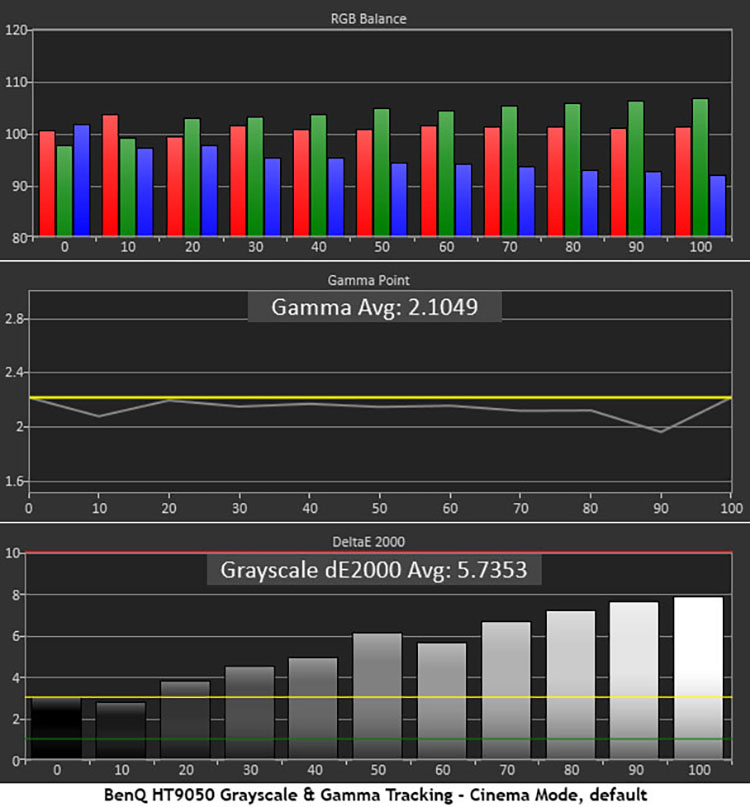
My initial measurements were a bit disappointing. I expect better out-of-box accuracy from a premium display such as the HT9050. Errors in white balance tend towards green and get more visible as the signal level rises from 20%. At 100%, the tint is easy to see. Gamma also tracks on the light side. Given the projector’s relatively low contrast, this isn’t necessarily a problem but I prefer to have it dialed in at 2.2 before making any subjective tweaks.
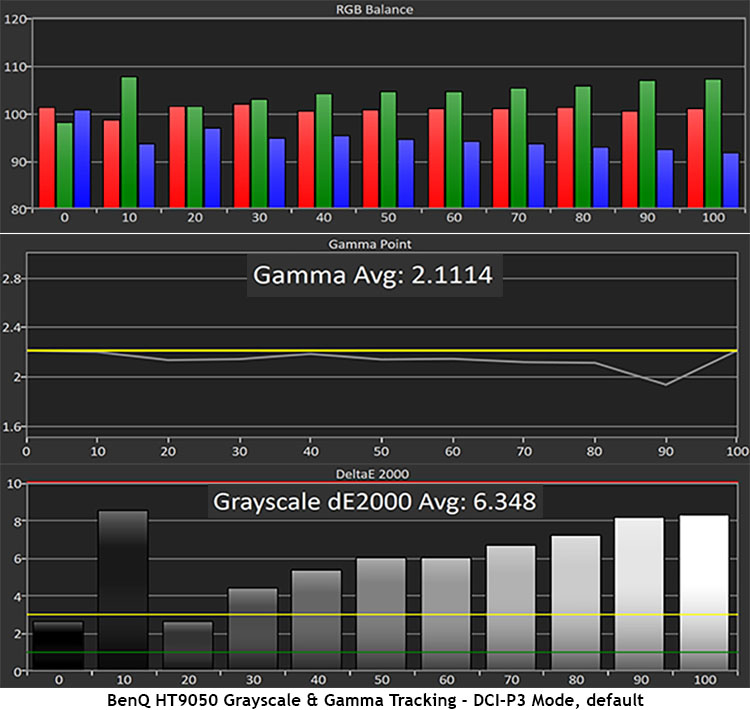
The DCI-P3 mode displays much the same behavior. A green tint can be seen at every signal level from 30% and higher. Gamma is just a little light with a spike in luminance at the 90% step.
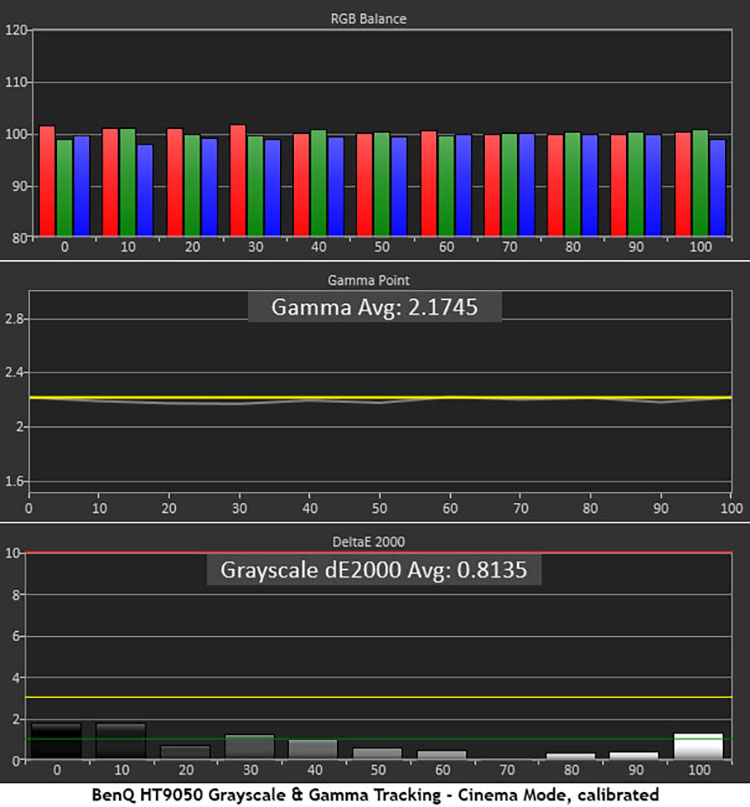
Luckily, BenQ has engineered the calibration controls with great precision. It takes some back-and-forth but the end result is reference-level accuracy. Not only is the average error well-below the visible threshold, gamma tracks almost perfectly. Once calibrated, the user can change the gamma preset to taste. Some content will benefit from a higher setting. Grayscale performance doesn’t get much better than this.

The DCI-P3 mode offers nearly equal accuracy with the only spoiler being a tiny green error at the 10% level. It’s barely visible in test patterns and complete non-issue in actual content. Like the Cinema mode, gamma runs just under the 2.2 line but if you want deeper contrast in certain content, simply raise the preset value.
The HT9050 has a DCI-P3 native color gamut. That means it should be able to hit Rec.709 with perfection. Like the grayscale controls, the projector’s color management system is very precise. In fact, it’s one of the best I’ve encountered of any display I’ve ever reviewed.
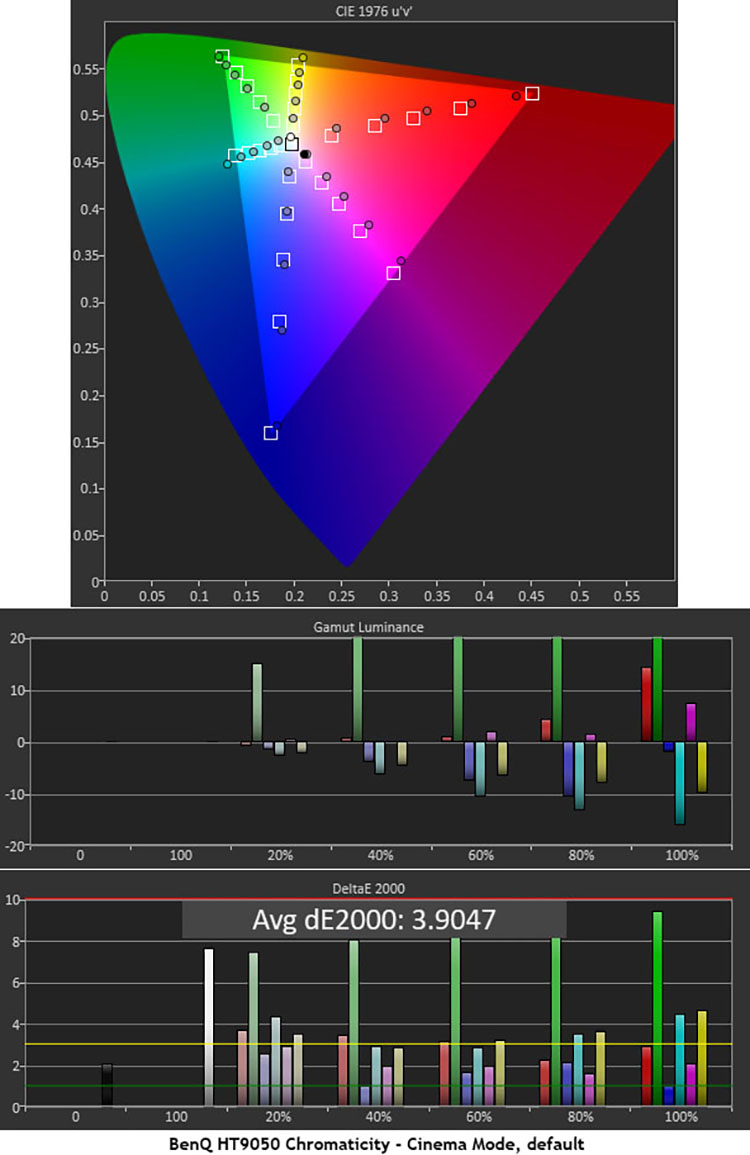
With a 3.9047dE average error level, the Rec.709 isn’t too far off in the Cinema mode. The main issue is with green luminance which is too high at every saturation point. You can also see slight hue errors in all three secondary colors.

The hue errors in DCI-P3 mode are even more pronounced, especially for cyan and yellow. They will need more help than a simple grayscale calibration can provide. The CMS has hue sliders with tremendous range and very fine resolution. I’ll also need to address luminance levels for the green primary.
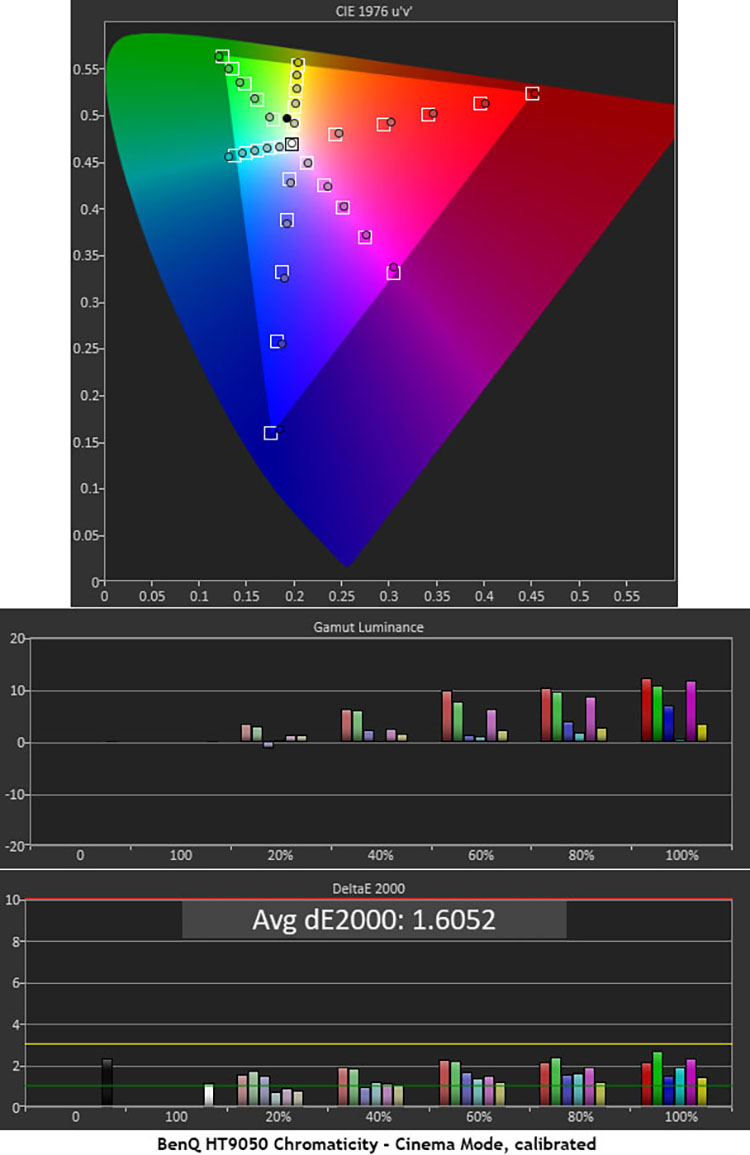
I don’t encounter too many displays that have such a precise and functional CMS. The sliders have tremendous resolution and some required changes of over 150 clicks. My patience was rewarded with superb tracking of both saturation and luminance for all six colors. There are no visible errors whatsoever.

DCI-P3 mode is the HT9050’s shining star after calibration. There are very few projectors that can average a color error of only .86dE over 36 measurements. Many professional displays can’t achieve this level of accuracy. Luminance levels are ideally balanced. This projector is the perfect excuse to start acquiring Ultra HD Blu-ray titles. The color is simply amazing.

It’s becoming less important for displays to properly process interlaced video. DVD collections are dwindling rapidly and even highly-compressed streaming content is delivered in a progressive format. The HT9050 manages to provide correct film-mode processing but fails the 2:2 video test. Resolution is superb with perfect rendering of the one-pixel burst patterns in every signal mode. I could tell no difference between RGB and component formats.
The HT9050 does not have an auto-iris, nor does it employ a variable-brightness light source like some other DLP projectors. Therefore, all content is displayed beholden to its native contrast capability.
After calibration, in the LED’s Economic mode, I recorded a white level of 38.7043fL, a black level of .0447fL, and a contrast ratio of 866.1:1. Setting the LED to Normal increased peak output to 56.4285fL with a black level of .0648 and 871.5:1 contrast.
The HT9050’s maximum light level is achieved in the Bright mode which offers 88.1843fL peak, .0992fL black, and 889.2:1 contrast.
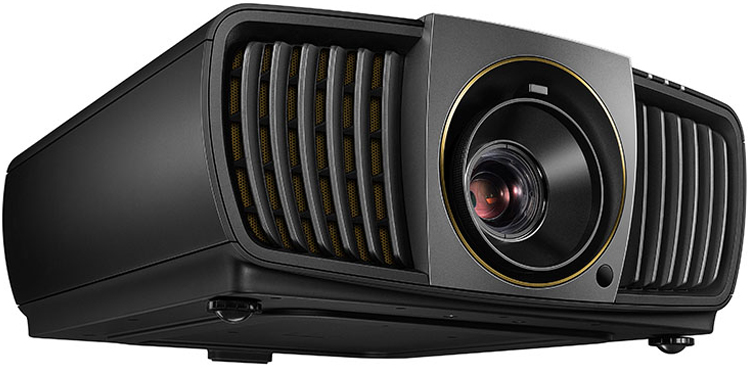
THE BENQ HT9050 ULTRA HD DLP PROJECTOR currently has no peer in the home theater market. It represents a good value and delivers excellent performance.
- Superb clarity in both still and moving images
- Reference-level color accuracy after calibration
- Precise picture controls
- Super-quiet fan
- Premium build quality
- Better out-of-box accuracy
- HDR support
- An auto-iris for improved contrast
When I first received information about the BenQ HT9050 Ultra HD DLP Projector, I was disappointed to see that it lacked HDR or an auto-iris. But after reviewing hundreds of displays, I’ve learned to never pass judgement solely based on specs. No matter what the numbers may say, there are projectors that rise above their test results and deliver a truly compelling image. The HT9050 is at the top of that list.
Whether you spin 1080p or Ultra HD Blu-rays, you’ll be mesmerized by the BenQ’s amazing level of detail, superb intra-image contrast, bright and vivid color delivered by CinematicColor, and the premium motion processing afforded by its advanced DLP technology. The home theater market may be dominated by LCD and LCoS designs but there is something about DLP that keeps me requesting those review samples. The advantages of a single-chip engine and the wide gamut afforded by a maintenance-free LED light source are obvious here. Despite less-than-impressive contrast numbers, I never found myself wishing for HDR while watching.
In my opinion, this projector is excellent but has upward potential. While HDR10 and Dolby Vision could be added with a firmware update, an auto-iris would have a greater impact on image quality. Even a manual version would raise the contrast level significantly. That being said, I would still recommend this projector as the sharpest lens-based display I’ve seen for under $10,000.


